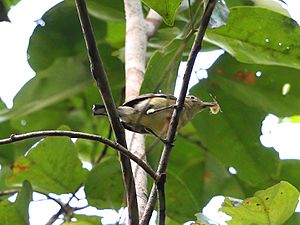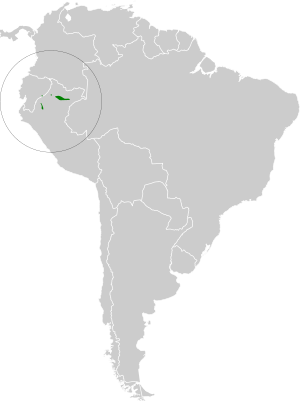Ancient antwren facts for kids
Quick facts for kids Ancient antwren |
|
|---|---|
 |
|
| Conservation status | |
| Scientific classification | |
| Genus: |
Herpsilochmus
|
| Species: |
gentryi
|
 |
|
The ancient antwren (Herpsilochmus gentryi) is a small, colorful bird that lives in warm, wet forests. It belongs to a bird family called Thamnophilidae, which includes many birds found in Central and South America. You can mostly find this special bird in the terra firme forests of northern Peru and southeastern Ecuador.
Scientists first officially described this bird in 1998. They named it after an American botanist, Alwyn Gentry, who studied plants. Sadly, one of the biggest dangers to the ancient antwren is that its forest home is slowly disappearing.
Contents
About the Ancient Antwren
How it Looks
The ancient antwren is a tiny bird, only about 10 to 11 centimeters (about 4 inches) long. That's roughly the length of a pen! It weighs about 10 to 11 grams, which is like the weight of two quarters.
Male and female ancient antwrens look a bit different, but not as much as some other birds in their group.
- Males: They have a solid black cap on their head. They also have a bright yellowish stripe above their eye, like an eyebrow. Their back and rump are dark gray, and their throat and belly are yellowish.
- Females and Young Birds: Their black cap might have white or yellow spots. Their chest and sides are usually a darker olive color than the males.
Both males and females have black feathers on their shoulders and wings that are tipped with white. Their wings are quite short. They also have a short tail with black feathers outlined in white.
Its Unique Song and Calls
The ancient antwren has a special song that sounds like a long series of notes. These notes start a bit higher and then get lower and slower. Its song is similar to the Todd's antwren, another bird it's related to.
This bird also makes different calls:
- Short "chups"
- Longer "tink" calls
- Rattle-like sounds
Scientists can tell the ancient antwren's calls apart from other similar birds by how they sound and their pattern.
Where it Lives
The ancient antwren lives only in humid terra firme forests. These are forests on high, dry ground in the Amazon basin in north-central Peru and southeastern Ecuador.
In Peru, it seems to prefer two types of these forests:
- Varillal: A forest with short, stunted trees that grow on white sand.
- Irapayal: An open forest where many palm trees grow underneath the taller trees.
In Ecuador, you can find it on the highest and driest parts of forest ridges. This bird seems to like areas where different types of habitats meet. It lives at elevations up to 200 meters (about 650 feet) high. Like other birds in its group, it prefers to stay high up in the forest canopy (the top layer of trees) or just below it. This bird doesn't migrate; it stays in the same area all year round.
Ancient Antwren Behavior
Breeding Habits
Scientists don't know a lot about how ancient antwrens raise their young. They think the breeding season might be early in the year, from January to March. This idea comes from looking at young birds' skulls and seeing families of birds together in April.
What and How it Eats
The ancient antwren looks for food high up in the trees, in the canopy or just below it. It "gleans" its prey, which means it picks insects off leaves and branches. We don't know exactly what it eats, but it likely enjoys insects like spiders and caterpillars.
When it forages, it moves actively, fluttering its wings and making short hops. Sometimes, you can see ancient antwrens foraging with other types of birds in mixed groups. They also forage in small family groups or with their mate.
Status and Dangers
The IUCN currently lists the ancient antwren as a species of "Least Concern" as of 2017. This means it's not considered to be in immediate danger of extinction.
However, because it was only discovered recently, scientists are still learning about how its population is changing. It's quite common in its favorite habitats in Peru but is rare and found only in specific spots in Ecuador.
The biggest dangers to the ancient antwren come from human activities like mining and oil exploration. These activities can lead to habitat loss or damage to the forests where the antwren lives. This is especially concerning because its preferred forest habitats are naturally uncommon in the Amazon region.
Images for kids
See also
 In Spanish: Tiluchí antiguo para niños
In Spanish: Tiluchí antiguo para niños




